Piano Rebuilding, how it works
At ManilaPianos Inc. we are striving to give our customers the largest selection of rebuilt high quality (grand) pianos in South East Asia. Certain older Steinway & Sons pianos and grand pianos and upright pianos are excellent candidates for restoration.
Lately new high end grand pianos are very expensive. Steinway & Sons are very expensive and in our opinion as piano industry insiders, new Steinway & Sons grand pianos are not as well manufactured today as they were in the past.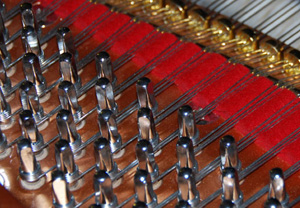
As a consumer you could get a very good deal and a better piano if you purchased an older Steinway & Sons providing you know what to look for. We also think it is very important to learn as much as you can before investing a large amount of money.
Problem areas to look out for:
- Most upright and grand pianos “look” good after they are "rebuilt" and sitting on a show room floor. The trouble is that most so called rebuilders are not capable of doing a good job. Or they may simply be unwilling to do a comprehensive job because they want to sell the piano for a lower price. This can be easily achieved by replacing fewer parts and spending less money on labour and a piano is parts and labor, nothing else!
- Another problem is that very few dealers and technicians have the capability, knowledge and/or the facilities to properly rebuild a grand piano. Most tuners and certainly almost all piano teachers do not know much about the workings of pianos at all.
- Also important is to ask what kind of quality parts were used to rebuild the piano. For example, a full set of RENNER hammers can cost upward of P40.000 while a full set of low quality hammers, which look virtually the same, will cost only P500 per set!
The hammers
They strike the strings of the piano like mallets. Each note has a different sized hammer. Larger ones are used to excite larger strings and are located on the left side of the keyboard while smaller ones strike the high notes at the right side of the piano. Hammers are made from sheep’s wool and there are many grades and kinds of wool. .png) Virgin wool refers to fibers that have not been recycled and then reconstituted into new wool. Piano hammers are often double felted which generally is considered a higher grade of hammer (shown in red). Often terms of pounds are used to indicate the size and weight of hammers which refers to the initial sheet of wool before cutting. 14lb hammers are ‘lighter’ while 16 – 18 lb hammers are ‘weightier’. Note that many of the piano makers produce their own hammers in their factories while others import hammers from specialists. Within each of the specialist companies there are also grades of hammers. For example Renner sells their “premium blue” as part of a series of hammers. Hammers are often reinforced by staples or “T-wires” to ensure they don’t come apart from the molding. The center wooden part of the hammer is called the molding. Traditionally they have been made from walnut, mahogany or hornbeam.
Virgin wool refers to fibers that have not been recycled and then reconstituted into new wool. Piano hammers are often double felted which generally is considered a higher grade of hammer (shown in red). Often terms of pounds are used to indicate the size and weight of hammers which refers to the initial sheet of wool before cutting. 14lb hammers are ‘lighter’ while 16 – 18 lb hammers are ‘weightier’. Note that many of the piano makers produce their own hammers in their factories while others import hammers from specialists. Within each of the specialist companies there are also grades of hammers. For example Renner sells their “premium blue” as part of a series of hammers. Hammers are often reinforced by staples or “T-wires” to ensure they don’t come apart from the molding. The center wooden part of the hammer is called the molding. Traditionally they have been made from walnut, mahogany or hornbeam.
The Strings
There are two types of strings on any piano. The treble plain steel wire makes up approximately the top 2/3 of the piano strings while the bass strings comprise the lowest 1/3 of the piano. Each note in the treble has three strings (tri-chord) while the bass has a mix of 2 strings (bi-chord) or 1 string per note (mono-chord).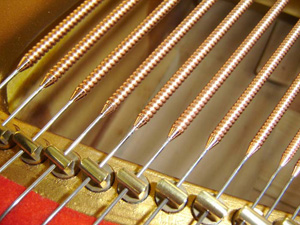 Bass strings are made from wrapping copper wire around a core of steel. Without question the most popular high grade plain wire comes from Röslau, Germany. Regarding bass strings however, there are several independent makers and many of the manufacturers wrap their own bass strings. There are also independent companies that manufacture custom sets of bass strings. The scale or design of strings - the length, thickness and tension are critical elements in what is perceived as the voice or signature from each manufacturer.
Bass strings are made from wrapping copper wire around a core of steel. Without question the most popular high grade plain wire comes from Röslau, Germany. Regarding bass strings however, there are several independent makers and many of the manufacturers wrap their own bass strings. There are also independent companies that manufacture custom sets of bass strings. The scale or design of strings - the length, thickness and tension are critical elements in what is perceived as the voice or signature from each manufacturer.
The Bridges
If you’ve ever played guitar, you’ll be aware of the importance of the bridge. The bridge is the transfer point of vibration from the strings to the soundboard. Why is this considered a sound producing element? In my mind I think of the bridge as not so much creating tone but as having the ability to drastically alter sound. If the transfer of vibration is inhibited, the overall piano tone can be dull, “thunky” or choked. Due to the nature and shape of piano bridges, some believe that it is cost prohibitive to build them out of one piece. Also, because there are approximately 18 tons of string tension on any piano, most makers have reinforced the bridges with a cross laminated piece called a cap. In more recent years, manufacturers have made vertically laminated bridges which in a sense act like sound ‘tubes’ transferring the sound through strips of wood. Still others make horizontally laminated bridges like layers. The term “cantilevered” refers to bridges that are shaped in such a way as to optimize placement and pressure on thee soundboard. Often layers are added or areas are cut away so that the contact area is optimized on the soundboard. Hand-notched bridges refer to the point where the string is terminated at the bridge pins. In order to vibrate freely, accuracy in the bridge notch is of extreme importance. Traditionally bridges are made from beech or maple. Some makers also incorporate mahogany and even ebony. Most bridges are made in the factory and there are no associated independent name brands for bridges.
Due to the nature and shape of piano bridges, some believe that it is cost prohibitive to build them out of one piece. Also, because there are approximately 18 tons of string tension on any piano, most makers have reinforced the bridges with a cross laminated piece called a cap. In more recent years, manufacturers have made vertically laminated bridges which in a sense act like sound ‘tubes’ transferring the sound through strips of wood. Still others make horizontally laminated bridges like layers. The term “cantilevered” refers to bridges that are shaped in such a way as to optimize placement and pressure on thee soundboard. Often layers are added or areas are cut away so that the contact area is optimized on the soundboard. Hand-notched bridges refer to the point where the string is terminated at the bridge pins. In order to vibrate freely, accuracy in the bridge notch is of extreme importance. Traditionally bridges are made from beech or maple. Some makers also incorporate mahogany and even ebony. Most bridges are made in the factory and there are no associated independent name brands for bridges.
The Sound Board, ribs and rim
The soundboard on a piano is the large sheet of wood which acts as a transducer transforming vibration into sound. The purpose of a soundboard is to make audible the signal created by the hammers striking the strings, transferred through the bridges. 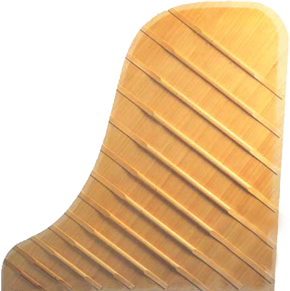 The soundboard is put under compression (not tension) and creates what is called ‘crown’, a slightly arced shape. Without question, the most talked about area and quite often the difference in cost between models has to do with the soundboard of a piano. Piano makers are offering solid versus laminated soundboards. Please note that there are many different terms being associated with laminated soundboards (such as triphonic, meniscus, surface-tension or veneered). For the purpose of clarity, if a piano soundboard has more than one layer, I have called it laminated because that is what it is: 2 or more layers glued together to produce one soundboard.
The soundboard is put under compression (not tension) and creates what is called ‘crown’, a slightly arced shape. Without question, the most talked about area and quite often the difference in cost between models has to do with the soundboard of a piano. Piano makers are offering solid versus laminated soundboards. Please note that there are many different terms being associated with laminated soundboards (such as triphonic, meniscus, surface-tension or veneered). For the purpose of clarity, if a piano soundboard has more than one layer, I have called it laminated because that is what it is: 2 or more layers glued together to produce one soundboard.
Among elite piano makers is the pursuit of clear, tight grained woods. Due to a shortage of slow growth timber, makers now are advertising high altitude or mountain spruce soundboards. The reasoning is this: higher altitude makes for colder, slower growth and thus tighter grain. Tighter grain is considered more resonant. Logging at high altitude however is costly and dangerous. Countries are often associated as well with types of wood (Austrian, Italian, Siberian, Bavarian and Canadian). The most common wood for soundboards is spruce and most companies manufacture in-house.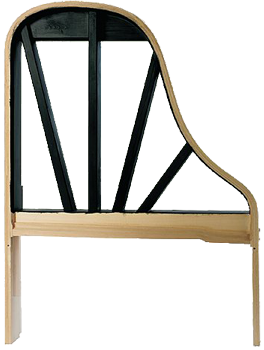
Ribs are attached to the under side of the soundboard and act as support for the crown. They also transfer tone perpendicular to the soundboard grain and secure the joints of the soundboard. The rim is the perimeter frame to the soundboard. Piano makers quite often advertise amount of ribs and whether they are notched to the inner rim denoting structural and acoustic cohesion. Philosophy on rim construction and materials vary greatly from maker to maker. Some have one continuous rim while others build it in pieces. The construction and components are company decisions and diversity in design varies from piano to piano. These parts are made in-house and there are no independent makers of rims and ribs advertised by manufacturers. There are instances however where piano makers will purchase ‘strung backs’ for uprights which include soundboard, frame, strings, and rim.
Consider that the modern piano has between 17 and 25 tons of string tension depending on the maker. The piano then needs to have a structure to support such tension. It is necessary to incorporate a framework to create not only tuning stability but also a rigid rim to the diaphragm of the soundboard. Back to front page.
The Iron Plate also called Harp
The iron plate is often the gold colored piece located on the inside of the piano. There are mainly two streams of thinking regarding the iron frame: sand cast or V-pro. Sand cast refers to the age old method of placing the mold into wet sand and then pouring molten iron into the hollowed space. V-Pro refers to Vacuum Process which sucks the iron into precision molds and requires very little if any finishing. 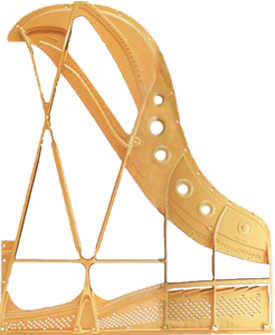 Traditional sand cast is somewhat laborious to finish. Some manufacturers have taken the tack of sand casting with CNC finishing (Computer Numerically Controlled a.k.a. computerized lathe). Decisions regarding casting are philosophical but are also driven by economics. V-Pro is very costly to set up and prohibits boutique piano makers from involvement in that process. Though some would argue that the casting and cooling methods are superior from one method to another, iron is relatively inert and musical contributions are negligible to the sound of the piano. Its primary purposes are rigidity and stiffness. Albeit more obscure but still noteworthy is the introduction to steel by some makers into mainstream manufacturing having a higher tensile strength than iron. Most iron plates are cast either in-house or purchased between piano makers.
Traditional sand cast is somewhat laborious to finish. Some manufacturers have taken the tack of sand casting with CNC finishing (Computer Numerically Controlled a.k.a. computerized lathe). Decisions regarding casting are philosophical but are also driven by economics. V-Pro is very costly to set up and prohibits boutique piano makers from involvement in that process. Though some would argue that the casting and cooling methods are superior from one method to another, iron is relatively inert and musical contributions are negligible to the sound of the piano. Its primary purposes are rigidity and stiffness. Albeit more obscure but still noteworthy is the introduction to steel by some makers into mainstream manufacturing having a higher tensile strength than iron. Most iron plates are cast either in-house or purchased between piano makers.
The Keybed and Frame
Keybed: The keybed refers to the frame beneath the piano keys. Piano manufacturing requires not only stability but also accuracy as it relates to the keybed. If the keybed is not ‘true’, that means then that the action parts that are supported by the keybed will also be out of alignment. 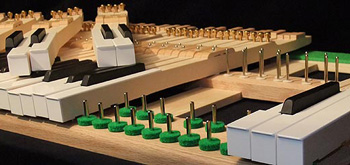 Subsequently for structural integrity, some manufacturers advertise a laminated keybed or a butcher block style keybed. Most often they are made from spruce or beech wood. Some manufacturers have also reinforced the keybed with a steel frame.
Subsequently for structural integrity, some manufacturers advertise a laminated keybed or a butcher block style keybed. Most often they are made from spruce or beech wood. Some manufacturers have also reinforced the keybed with a steel frame.
Frame: The frame of the piano aids the cast iron plate in structural integrity. Underneath a grand piano you will see beams. On the back of an upright piano these beams are referred to as back posts. Generally speaking, more beams equates to greater strength, stability and soundboard crown retention. Configuration and greater number of beams are considered sales advantages and part of each company’s manufacturing design.
Some manufacturers have also incorporated steel to aid structural integrity into the framework.
Tuning pins and pin block
Tuning pins: The tuning pins on any piano are made from steel. They are a structural element in so far as the pins hold the string tension in place without which the piano would not be able to be tuned. Fine thread is cut on the tuning pins and they are usually reverse threaded so as to not come undone under pressure. Plating of pins (either in nickel, chrome or ‘blue’) prevent rust. Pinblock or Wrestplank: 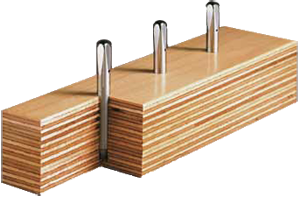 The tuning pins fit into holes precisely drilled into a plank called the pinblock or wrestplank (“wrest” similar to “wrench” means to turn, thus the wrestplank is the block of wood where one would wrest the tuning pins). Modern piano makers all agree that multi-laminate layers make for the best pinblocks. What differentiates them is the amount of layers. Some have 7 laminations while others have 19 however more is not necessarily better. They are usually made from a dense wood such as maple or beech. It is located under the gold cast iron plate and usually hidden from plain view. Many pinblocks are made in the factory.
The tuning pins fit into holes precisely drilled into a plank called the pinblock or wrestplank (“wrest” similar to “wrench” means to turn, thus the wrestplank is the block of wood where one would wrest the tuning pins). Modern piano makers all agree that multi-laminate layers make for the best pinblocks. What differentiates them is the amount of layers. Some have 7 laminations while others have 19 however more is not necessarily better. They are usually made from a dense wood such as maple or beech. It is located under the gold cast iron plate and usually hidden from plain view. Many pinblocks are made in the factory.
Action
The action of a piano is the mechanical system of levers that transfer the touch of a piano key to the strike of the hammer towards the string. In order to create sufficient power at the piano, each action has an “action ratio” that in effect multiplies the force of the key to the hammers. If each note requires upwards of 60 parts multiplied by 88 notes on the piano, each piano action then contains about 5,000 parts. What is referred to as the ‘touch’ of a piano is directly related to the action of a piano. 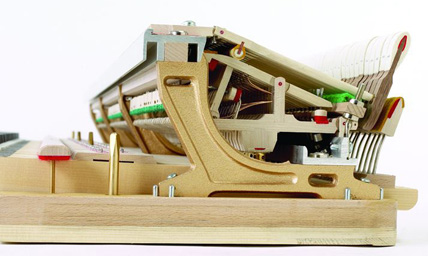 The control at your finger tips to make a piano louder or softer occurs in the action. Subsequently, the design, the components and the consistency in manufacturing of the action are equally critical to the sound producing elements of the piano. Types and styles of actions are as wide spread as there are types of engines in cars. With the introduction of computer assisted design (CAD) however, piano actions have consolidated considerably over several decades. The weight and subsequent balance of piano hammers, the ratio of the whippen assembly (intricate lever system), the length of the keys, and the materials for all parts have a bearing into the overall picture of how the piano will play. Some manufacturers have incorporated the use of synthetic parts while others have held fast to more traditional components. Pictured is the side profile of a grand piano action while on the following page is an action from an upright piano.
The control at your finger tips to make a piano louder or softer occurs in the action. Subsequently, the design, the components and the consistency in manufacturing of the action are equally critical to the sound producing elements of the piano. Types and styles of actions are as wide spread as there are types of engines in cars. With the introduction of computer assisted design (CAD) however, piano actions have consolidated considerably over several decades. The weight and subsequent balance of piano hammers, the ratio of the whippen assembly (intricate lever system), the length of the keys, and the materials for all parts have a bearing into the overall picture of how the piano will play. Some manufacturers have incorporated the use of synthetic parts while others have held fast to more traditional components. Pictured is the side profile of a grand piano action while on the following page is an action from an upright piano. 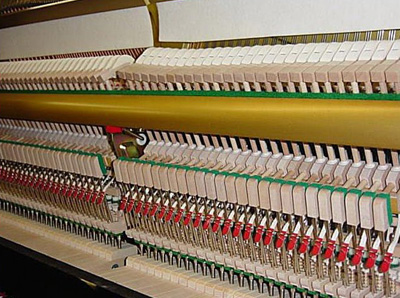
1. Component material, usually out of a more dense wood like maple or hornbeam. New materials such as ABS carbon fiber are also being used, they are questionable at best.
2. Action rail is the common rail that holds hammers, shanks and flanges securely in place, usually made out of extruded aluminum or dense wood such as maple or beech.
3. Action brackets – these are structural frame pieces that attach the action to the piano body. Generally more brackets are considered better for structural integrity.
4. Type of action – both “compressed” actions (miniature) and “drop” actions (for uprights shorter than 39”) have been eliminated from modern manufacturing and only “direct blow” actions remain as standard in both grand and upright pianos.
5. Action name – many manufacturers name their own actions in hopes of having a sales advantage but of greater consideration is the components.
Outsourcing of action parts has been going on for decades (almost centuries) where piano companies will build the frame, soundboard and strings and then have a piano specialist company to build actions. That said, there are many piano companies continue to build high quality actions in-house.
Keys and Keytops
The piano keys are most often made out of spruce with a variety of keytop materials. In 1975, the use of elephant ivory was banned by the Convention on International Trade in Endangered Species (CITES). Since then a variety of substances have been developed for key surfaces. Most common is plastic for the use of keytops but other makers have gone to great lengths to simulate the porous feel of ivory.  Names such as ivorine, ivorite, neotex, polyplex, ivoplast, and PMMA (Poly methyl methacrylate) are all used as advertising features of high grade keytops. Boutique makers attempting to remain organic also use cow bone as replacement for ivory. The black keys are manufactured out of either dense wood or plastic but some have used traditional ebony for the keytops.
Names such as ivorine, ivorite, neotex, polyplex, ivoplast, and PMMA (Poly methyl methacrylate) are all used as advertising features of high grade keytops. Boutique makers attempting to remain organic also use cow bone as replacement for ivory. The black keys are manufactured out of either dense wood or plastic but some have used traditional ebony for the keytops.
The spruce keys usually are “balanced” or “weighted”. This means that lead weights have been inserted into the wood of the keys to help balance the feel of the action.
Pedals
Modern pianos are equipped with three pedals. The right pedal is known as the sustain or damper pedal. When a note is depressed on the keyboard, the felt touching the string called the damper block is lifted up allowing the note to vibrate freely. When your finger releases the note, the damper drops down again and mutes the string. The sustain pedal lifts all the dampers simultaneously allowing the tone to continue to resound regardless of whether the note has been released at the key. The left pedal is commonly called the soft pedal. It is also referred to as the 'una corda' on grands. 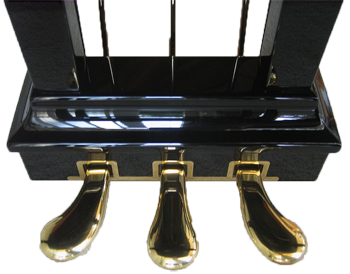 Grand pianos and uprights operate very differently. On a grand piano, the entire keyboard shifts from left to right making the hammers strike on 'fresh felt'. In addition, one string (una corda) is not struck by the hammers and so it becomes a quieter, more intimate tone. Due to the physical constraints of upright construction, it is not possible to have an una corda pedal. The hammers are moved closer to the strings and in essence create a sort of soft pedal because the strike point is closer. It acts more like volume limiter by reducing the amount of maximum volume achieved with a reduced strike distance. The center pedal, however has a variety of functions from sostenuto (selective sustain), bass damper (just lifting the bass dampers) or practice mute (also called attenuator pedal which drops a piece of felt in between the strings and the hammers). Some have also been set up to act as a ‘quiet play’ digital piano which blocks the hammers from striking the strings and the piano can then be used with headphones. The connecting rods and levers are called the pedal assembly or trapwork. These are made from either aluminum tubing, steel, solid brass or wood. The pedals are made from cast brass but have also been manufactured out of steel and plated with either chrome, nickel or brass. So all in all we have:
Grand pianos and uprights operate very differently. On a grand piano, the entire keyboard shifts from left to right making the hammers strike on 'fresh felt'. In addition, one string (una corda) is not struck by the hammers and so it becomes a quieter, more intimate tone. Due to the physical constraints of upright construction, it is not possible to have an una corda pedal. The hammers are moved closer to the strings and in essence create a sort of soft pedal because the strike point is closer. It acts more like volume limiter by reducing the amount of maximum volume achieved with a reduced strike distance. The center pedal, however has a variety of functions from sostenuto (selective sustain), bass damper (just lifting the bass dampers) or practice mute (also called attenuator pedal which drops a piece of felt in between the strings and the hammers). Some have also been set up to act as a ‘quiet play’ digital piano which blocks the hammers from striking the strings and the piano can then be used with headphones. The connecting rods and levers are called the pedal assembly or trapwork. These are made from either aluminum tubing, steel, solid brass or wood. The pedals are made from cast brass but have also been manufactured out of steel and plated with either chrome, nickel or brass. So all in all we have:
- the sound board
- the pinblock
- the pins
- the strings
- the bridges
- the ribs
- the agraffes
- the plate
- the lettering
- the dampers
- the different felts
- the hammers
- the shanks
- the wippens
- the backchecks
- the keys
- the key coverings
- the bushings
- the balance rail
- the balance rail bushings
- the key end felts
- the key frame
- the let off felts
- the action frame
- the damper under lever action
- the damper guide rail
- the pedal lyre and trap work
- the music desk
- the legs
- the inner rim
- the outer rim
- the brass hardware or
- the plated hardware.
The action parts and regulation we made a separate chapter. Please click " regulation know-how" to read up about the parts and the labor.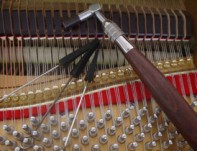
Comments
Rebuilding should give the consumer a "brand new' used piano. In the case of a Steinway and Sons you will get a better than new piano and you will pay much less! We hope that after studying our comments carefully you will now know that there is a huge difference in quality of rebuilding. Back to front page.
Our quality Promise:
All work on our used grand pianos is done locally and is inspected by us. All regulation work and installation of new actions, as well as voicing, is done in our facility, the customer's house or concert hall and comes with a long guarantee.